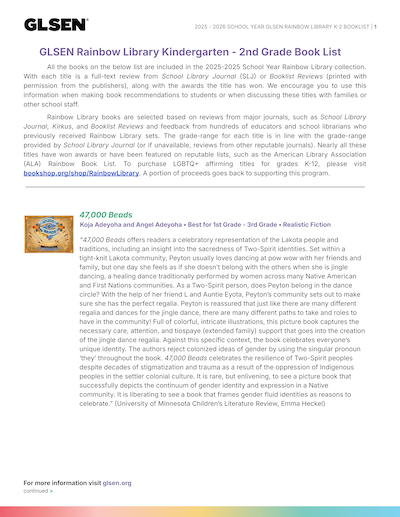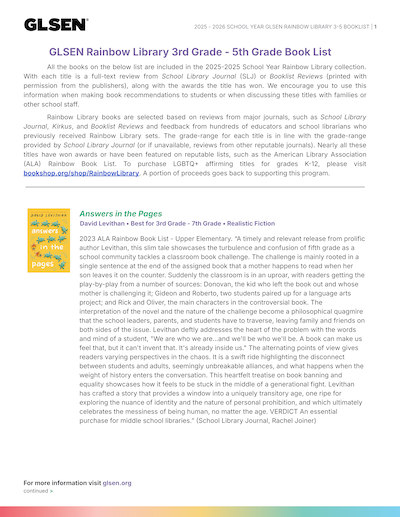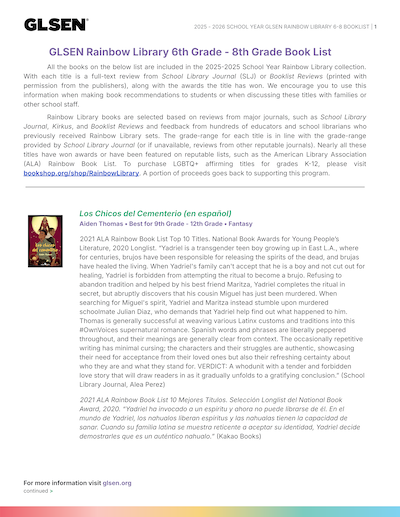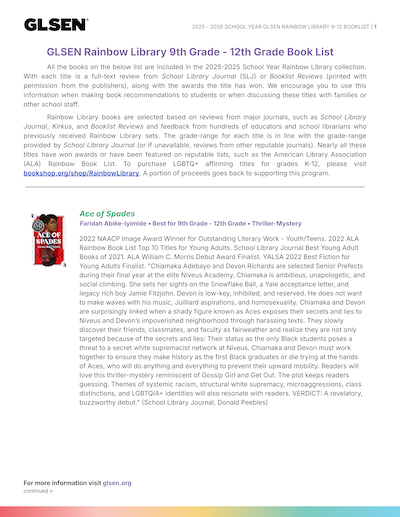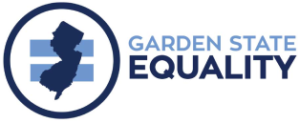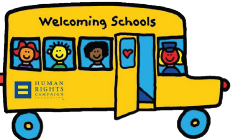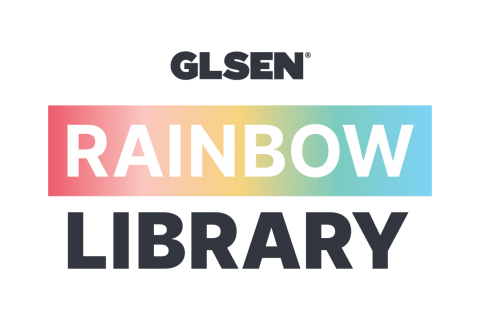
GLSEN's Rainbow Library
The Rainbow Library is a GLSEN program that centers intersectional literacy and learning. The program includes diverse book lists for grades K-2, 3-5, 6-8, and 9-12, lesson plans, resources for inclusive literary learning, and more. Starting as a local project by a GLSEN Chapter, the initiative has since moved into a national program that has reached over 6 million students nationwide and spans across 32 states.
At GLSEN, we believe representation matters deeply. Fewer than 1 in 5 students report ever being taught positive representations of LGBTQ+ people, history, or events in school. Programs like the Rainbow Library help fill those gaps—giving young learners both mirrors to see their own experiences and windows into the lives of others, fostering belonging, empathy, and possibility.
Explore more about the Rainbow Library below and share with a peer to help us Rise Up and ensure all students feel seen and heard in schools today.
ABOUT THE RAINBOW LIBRARY:
According to GLSEN’s 2021 National School Climate Survey, 68% of LGBTQ+ students reported hearing anti-LGBTQ+ remarks often or frequently at school. Less than half of students said they had access to LGBTQ+ inclusive resources at their school library and less than 1 in 5 students said that they were taught an LGBTQ+ inclusive curriculum.
Incorporating these texts into your classroom or school library can help turn the course for LGBTQ+ young people. Reading LGBTQ+ affirming texts, and leading conversations with students about these texts can dismantle harmful stereotypes among all students, and among LGBTQ+ youth, prompt deeper self-understanding, affirm their self-worth, and reinforce that they are valued community members. This program can also improve the academic performance of LGBTQ+ readers because they will see themselves in literature, history, and more, and spark them to engage more deeply with these subjects.
LGBTQ+ affirming books, and especially, lessons that are strengthened with LGBTQ+ content, have positive impacts for LGBTQ+ students. According to GLSEN’s 2021 National School Climate Survey, LGBTQ+ students at schools with LGBTQ+ inclusive curriculum (which include LGBTQ+ inclusive books) are less likely to feel unsafe because of their sexual orientation and gender expression, have higher self-esteem and lower levels of depression, and have higher GPAs.
Book Placement and Labeling: We encourage you to showcase these books for readers. Our long-term recommendation, however, is to incorporate these books into your classroom or school library’s existing book collection, under the same organizational system that applies to other texts. We recommend against adding any additional sticker to the exterior of the book marking it as an LGBTQ+ affirming text. This is because it may not be safe for many young readers to display to others (such as peers or family members) that they are reading an LGBTQ+ affirming book. If you have a digital catalog for your books, we do encourage you to add a keyword tag for these books in your online system (“LGBTQ+ affirming” can be the tag), so readers can easily find them when searching.
GLSEN Rainbow Library Elementary Lesson Plans
All children deserve to see themselves in what they learn. Yet, according to GLSEN’s 2021 National School Climate Survey, less than 1 in 5 students said that they were taught an LGBTQ+ inclusive curriculum. LGBTQ+ youth of color are even less likely to see themselves represented in school books and lessons. When an inclusive curriculum is in place, LGBTQ+ students are less likely to feel unsafe because of their sexual orientation or gender expression, they have higher self-esteem and lower levels of depression, and they have higher GPAs.
GLSEN’s Rainbow Library English and Spanish lesson plans support educators to use Rainbow Library books in their instruction. Aligned to Common Core ELA Standards, Learning for Justice Social Justice Standards, and National Council for the Social Studies C3 Social Studies Standards, the lessons can be taught across a range of subjects (such as reading, humanities/social studies, or SEL), and connect to a variety of units and topics.
Seventeen of the below lessons are in English, and three are in Spanish. Each Spanish lesson plan has an English lesson counterpart, facilitating usage in bilingual/multilingual classrooms.
Additionally, each lesson has recommended accommodations and modifications, as well as other grades listed that the lesson can be adapted for.
Kindergarten
One of a Kind Like Me / Único Como Yo - Character Feelings (lesson in English)
- Aim - Students will figure out characters' feelings by noticing key details in the text and illustrations.
- Common Core ELA Standard - RL. K.7 - With prompting and support, describe the relationship between illustrations and the story in which they appear (e.g., what moment in a story an illustration depicts).
- Learning For Justice Standard - DI.K-2.7 - I can describe some ways that I am similar to and different from people who share my identities and those who have other identities.
- C3 Social Studies Standard - D2.CIV.2.K-2 - Explain how all people, not just official leaders, play important roles in a community
- Text & Author - One of a Kind Like Me by Laurin Mayeno
One of a Kind Like Me / Único Como Yo - Sentimientos de los Personajes (lección en español)
- Enfoque - Los estudiantes descubrirán los sentimientos de los personajes al notar detalles clave en el texto y las ilustraciones. SLA Estándar
- Common Core - RL. K.7 - Con sugerencias y apoyo, describen la relación entre las ilustraciones y el cuento en donde aparecen (por ejemplo: qué momento de un cuento representa la ilustración).
- Estándar de la justicia social - DI.K-2.7 - Puedo describir algunas formas en las que soy similar y diferente de las personas que comparten mis identidades y de aquellas que tienen otras identidades.
- C3 Estándar de los estudios sociales - D2.CIV.2.K-2 - Explicar cómo todas las personas, no sólo los líderes oficiales, desempeñan papeles importantes en una comunidad.
- Texto y Autor - Único como yo por Laurin Mayeno
What Are Your Words? - Similar & Different Character Traits
- Aim - Students will discuss how characters are similar and different by noticing what they think, say, and do.
- Common Core ELA Standard - RL. K.9 - With prompting and support, compare and contrast the adventures and experiences of characters in familiar stories."
- Learning For Justice Standard - ID.K-2.1 - I know and like who I am and can talk about my family and myself and name some of my group identities.
- C3 Social Studies Standard - N/A
- Text & Author - What Are Your Words? by Katherine Locke
First Grade
47,000 Beads - Central Message
- Aim - Students will learn about Lakota traditions by figuring out the story's central message.
- Common Core ELA Standards - RL.1.2 - Retell stories, including key details, and demonstrate understanding of their central message or lesson.
- Learning For Justice Standards - ID.K-2.1 - I know and like who I am and can talk about my family and myself and name some of my group identities.
- C3 Social Studies Standard - D2.CIV.2.K-2 Explain how all people, not just official leaders, play important roles in a community
- Text & Author - 47,000 Beads by Angel Adeyoha & Koja Adeyoha
My Rainbow - Key Details
- Aim - Students will understand that it’s important to care about the feelings of people with similar and different group identities.
- Common Core ELA Standard - RL 1.1 - Ask and answer questions about key details in a text.
- Learning For Justice Standard - DI.K-2.9 - I know everyone has feelings, and I want to get along with people who are similar to and different from me.
- C3 Social Studies Standard - D2.CIV.2.K-2 - Explain how all people, not just official leaders, play important roles in a community
- Text & Author - My Rainbow by Trinity Neal & DeShanna Neal
The Boy & The Bindi - Character Feelings
- Aim - Students will figure out how a character feels about something by noticing key details.
- Common Core ELA Standard - RL.1.4 - Identify words and phrases in stories or poems that suggest feelings or appeal to the senses.
- Learning For Justice Standard - ID.K-2.2 - I can talk about interesting and healthy ways that some people who share my group identities live their lives.
- C3 Social Studies Standard - N/A
- Text & Author - The Boy & The Bindi by Vivek Shraya
Second Grade
Sharice’s Big Voice: A Native Kid Becomes a Congresswoman - Character Traits
- Aim - Students will explain how a person's traits can help them become a leader.
- Common Core ELA Standard - RL 2.3 Describe how characters in a story respond to major events and challenges.
- Learning For Justice Standard - JU.K-2.15 - I know about people who helped stop unfairness and worked to make life better for many people.
- C3 Social Studies Standard - D2.Civ.6.K-2. Describe how communities work to accomplish common tasks, establish responsibilities, and fulfill leadership roles.
- Text & Author - Sharice’s Big Voice: A Native Kid Becomes a Congresswoman by Sharice Davids & Nancy K. Mays
When Aidan Became a Brother - Key Details (lesson in English)
- Aim - Students will ask and answer questions to understand how Aidan helps his family get ready for his new sibling.
- Common Core ELA Standard - RL 2.1 Ask and answer such questions as who, what, where, when, why, and how to demonstrate understanding of key details in a text.
- Learning For Justice Standard - ID.K-2.5 - I see that the way my family and I do things is both the same as and different from how other people do things, and I am interested in both.
- C3 Social Studies Standard - D2.CIV.2.K-2 Explain how all people, not just official leaders, play important roles in a community
- Text & Author - When Aidan Became a Brother by Kyle Lukoff
Cómo Aidan llegó a ser un Hermano - Detalles Clave (lección en Español)
- Enfoque - Los estudiantes harán preguntas y las responderán para comprender cómo Aidan ayuda a su familia a prepararse para el nuevo bebé. SLA Estándar
- Common Core - RL 2.1 - Formular y responder a preguntas como quién, qué, dónde, cuándo, por qué y cómo para demostrar comprensión de los detalles clave de un texto.
- Estándar de la justicia social - ID.K-2.5 - Entiendo que la forma en que mi familia y yo hacemos las cosas es igual y diferente a la forma en que otras personas hacen las cosas, y me interesan ambas.
- C3 Estándar de los estudios sociales - D2.CIV.2.K-2 - Explicar cómo todas las personas, no solo los líderes oficiales, desempeñan papeles importantes en una comunidad.
- Texto y Autor - Cómo Aidan llegó a ser un hermano por Kyle Lukoff
Third Grade
When We Love Someone, We Sing to Them / Cuando Amamos Cantamos - Central Message (lesson in English)
- Aim - Students will recount a story about a boy who learns to take part in a Mexican tradition, the serenata.
- Common Core ELA Standard - RL.3.2 - Recount stories, including fables, folktales, and myths from diverse cultures; determine the central message, lesson, or moral and explain how it is conveyed through key details in the text.
- Learning For Justice Standard - DI.3-5.6 - I like knowing people who are like me and different from me, and I treat each person with respect.
- C3 Social Studies Standard - D2.Civ.6.3-5 - Describe ways in which people benefit from and are challenged by working together, including through government, workplaces, voluntary organizations, and families.
- Text & Author - When We Love Someone, We Sing to Them by Ernesto Javier Martínez
When We Love Someone, We Sing to Them / Cuando Amamos Cantamos - Mensaje Central (Lección en Español)
- Enfoque - Los estudiantes recontarán una historia sobre un niño que aprende a participar en una tradición mexicana, la serenata. SLA Estándar
- Common Core - RL.3.2 - Contar historias, incluidas fábulas, cuentos populares y mitos de diversas culturas; determinar el mensaje, lección o moraleja central y explicar cómo se transmite a través de detalles clave en el texto.
- Estándar de la justicia social - DI.3-5.6 - Me gusta conocer personas como yo y diferentes a mí, y trato a cada persona con respeto.
- C3 Estándar de los estudios sociales - D2.Civ.6.3-5 - Describir las formas en que las personas se benefician y enfrentan el desafío de trabajar juntas, incluso a través del gobierno, los lugares de trabajo, las organizaciones voluntarias y las familias.
- Texto y Autor - Cuando Amamos Cantamos por Ernesto Javier Martínez
A Song for the Unsung: Bayard Rustin, the Man Behind the 1963 March on Washington - Lesson 1 - Key Details & Main Idea
- Aim - Students will use key details to ask and answer questions about Bayard Rustin and the ways others treated him.
- Common Core ELA Standard - RI.3.2 - Determine the main idea of a text; recount the key details and explain how they support the main idea.
- Learning For Justice Standard - JU.3-5.13 - I know that words, behaviors, rules and laws that treat people unfairly based on their group identities cause real harm.
- C3 Social Studies Standard - D2.His.3.3-5. Generate questions about individuals and groups who have shaped significant historical changes and continuities.
- Text & Author - A Song for the Unsung: Bayard Rustin, the Man Behind the 1963 March on Washington by Rob Sanders and Carole Boston Weatherford
A Song for the Unsung: Bayard Rustin, the Man Behind the 1963 March on Washington - Lesson 2 - Sequence & Cause/Effect
- Aim - Using sequence and cause/effect vocabulary, students will figure out how Bayard Rustin brought more justice and fairness to the world.
- Common Core ELA Standard - RI.3.3 - Describe the relationship between a series of historical events, scientific ideas or concepts, or steps in technical procedures in a text, using language that pertains to time, sequence, and cause/effect.
- Learning For Justice Standard - JU.3-5.15 - I know about the actions of people and groups who have worked throughout history to bring more justice and fairness to the world.
- C3 Social Studies Standard - D2.His.1.3-5. Create and use a chronological sequence of related events to compare developments that happened at the same time.
- Text & Author - A Song for the Unsung: Bayard Rustin, the Man Behind the 1963 March on Washington by Rob Sanders and Carole Boston Weatherford
If You're a Kid Like Gavin - Uncovering Word Meanings
- Aim - Students will uncover the meanings of unknown words to understand how Gavin Grimm fought injustice and changed his school's rules.
- Common Core ELA Standard - RI.3.4 - Determine the meaning of general academic and domain-specific words and phrases in a text relevant to a grade 3 topic or subject area.
- Learning For Justice Standard - AC.3-5.19 - I will speak up or do something when I see unfairness, and I will not let others convince me to go along with injustice.
- C3 Social Studies Standard - D2.Civ.12.3-5. Explain how rules and laws change society and how people change rules and laws.
- Text & Author - If You're a Kid Like Gavin by Gavin Grimm and Kyle Lukoff
Fourth Grade
Ana on the Edge - Lesson 1 - Specific Details to Describe Characters
- Aim - Students will use specific details to describe characters in Ana on the Edge.
- Common Core ELA Standard - RL.4.3 - Describe in depth a character, setting, or event in a story or drama, drawing on specific details in the text (e.g., a character's thoughts, words, or actions).
- Learning For Justice Standard - ID.3-5.1 - I know and like who I am and can talk about my family and myself and describe our various group identities.
- C3 Social Studies Standard - N/A
- Text & Author - Ana on the Edge by A.J. Sass
Ana on the Edge - Lesson 2 - Specific Details to Describe Events
- Aim - Students will use specific details to describe events in Ana on the Edge.
- Common Core ELA Standard - RL.4.3 - Describe in depth a character, setting, or event in a story or drama, drawing on specific details in the text (e.g., a character's thoughts, words, or actions).
- Learning For Justice Standard - ID.3-5.3 - I know that all my group identities are part of who I am, but none of them fully describes me and this is true for other people too.
- C3 Social Studies Standard - N/A
- Text & Author - Ana on the Edge by A.J. Sass
Ana on the Edge - Lesson 3 - Character Changes / Theme
- Aim - Students will determine the theme of Ana on the Edge by summarizing key events and character changes.
- Common Core ELA Standard - RL.4.2 - Determine a theme of a story, drama, or poem from details in the text; summarize the text.
- Learning For Justice Standard - DI.3-5.8 - I want to know more about other people’s lives and experiences, and I know how to ask questions respectfully and listen carefully and non-judgmentally
- C3 Social Studies Standard - N/A
- Text & Author - Ana on the Edge by A.J. Sass
Fifth Grade
Answers in the Pages - Lesson 1 - Text Structure / Key Details
- Aim - Students will use key details to determine the structure of Answers in the Pages.
- Common Core ELA Standard - RL.5.5 - Explain how a series of chapters, scenes, or stanzas fits together to provide the overall structure of a particular story, drama, or poem.
- Learning For Justice Standard - DI.3-5.7 - I have accurate, respectful words to describe how I am similar to and different from people who share my identities and those who have other identities.
- C3 Social Studies Standard - D2.Civ.10.3-5. Identify the beliefs, experiences, perspectives, and values that underlie their own and others’ points of view about civic issues.
- Text & Author - Answers in the Pages by David Levithan
Answers in the Pages - Lesson 2 - Quoting to Make Inferences & Predictions
- Aim - Students will quote from Answers in the Pages to make inferences and predictions.
- Common Core ELA Standard - RL.5.1 - Quote accurately from a text when explaining what the text says explicitly and when drawing inferences from the text.
- Learning For Justice Standard - JU.3-5.12 - I know when people are treated unfairly, and I can give examples of prejudice words, pictures and rules.
- C3 Social Studies Standard - D2.Civ.6.3-5. Describe ways in which people benefit from and are challenged by working together, including through government, workplaces, voluntary organizations, and families.
- Text & Author - Answers in the Pages by David Levithan
Answers in the Pages - Lesson 3 - Theme
- Aim - Students will summarize the interwoven narratives of Answers in the Pages to explain the text's theme.
- Common Core ELA Standard - RL.5.2 - Determine a theme of a story, drama, or poem from details in the text, including how characters in a story or drama respond to challenges or how the speaker in a poem reflects upon a topic; summarize the text.
- Learning For Justice Standard - AC.3-5.20 - I will work with my friends and family to make our school and community fair for everyone, and we will work hard and cooperate in order to achieve our goals.
- C3 Social Studies Standard - D2.Civ.11.3-5. Compare procedures for making decisions in a variety of settings, including classroom, school, government, and/or society.
- Text & Author - Answers in the Pages by David Levithan
Additional Curricular Resources
Garden State Equality and Make It Better for Youth
The LGBTQ+ organizations Make It Better for Youth and Garden State Equality developed LGBTQ+ affirming lesson plans that span subjects including English/Language Arts, social studies, science, math, visual/performing arts, and world languages, and currently range from 2nd through 12th grades. The resources can be accessed here.
GLSEN
GLSEN, the largest LGBTQ+ inclusivity education advocacy organization, has dozens of lesson plans and learning activities for grades K-12. Check out our Elementary Resources, LGBTQ History, & Activities Bank
The Massachusetts Safe Schools Program for LGBTQ Students
The Massachusetts Safe Schools Program offers curricular materials to help schools provide for LGBTQ-inclusive lessons. These resources range from hour-long discussions to multi-day lessons, and “help students value the contributions of LGBTQ people and understand their place in history, literature, and other fields.” A list of topics the curricular materials cover is here, and the form to request the materials is here.
The Human Rights Campaign Welcoming Schools Program
HRC’s Welcoming Schools Program focuses specifically on building LGBTQ+ inclusivity at the elementary school level. There are dozens of elementary lesson plans on their website that cover topics such as understanding gender, supporting transgender students, and welcoming all families. These lesson plans can be accessed here.
Penguin Classroom
Penguin has learning guides for LGBTQ+ affirming texts, including Darius the Great Is Not Okay (for middle school students), among other texts. Access those here.
Responding to Anti-LGBTQ Censorship Attempts
All Rainbow Library recipients hear firsthand from readers the positive impacts that these books have for them. However, it is important to be prepared in case someone attempts to censor or ban any Rainbow Library books. Here’s what we recommend you do.
- Assert Students’ Rights: If a member of school or district leadership attempts to ban a Rainbow Library book, explain that the First Amendment protects every student’s right to read books with LGBTQ+ characters and history. In Case v Unified School District, a federal district court in Kansas reversed a school district’s ban on a book about a romance between two female characters. In Island Trees Union Free School District v Pico, the Supreme Court ruled that “school boards may not remove books from school libraries simply because they dislike the ideas contained in those books.” Make clear to those in opposition that book bans fail in court and result in expensive lawsuits for schools and districts.
- Gather Information on Contested Books: A school board or administrator cannot unilaterally ban a book. If there is a formal challenge, it must go through the library’s reconsideration policy, which should involve a reconsideration committee. To prepare for that scenario, use the summary pages that came with your Rainbow Library as well as external resources, such as Follett Titlewave, to assemble reviews and lists of awards each book has won. This will help you and others explain why these books belong in your school library. The American Library Association’s Office of Intellectual Freedom can provide additional support if you need.
- Partner with Community Members to Fight Censorship: Connect with others in your area to oppose the ban attempt. Invite supporters of affirming books to attend any public meetings (such as a school board meeting or library board meeting) where the book ban attempt is addressed. Potential supporters can include a GSA club advisor, a local GLSEN chapter or PFLAG chapter, or your state association of school librarians. Public comments from students and families in opposition to book bans have been especially effective at helping defeat recent censorship attempts. Students and family members should clearly communicate the importance of these books for LGBTQ+ students, and the negative message that a ban of LGBTQ+ affirming books would send to LGBTQ+ students.
Additional Resources
One-on-One Support
National Coalition Against Censorship Book Challenge Crisis Hotline
American Library Association Office of Intellectual Freedom Book Challenge Reporting Form & Assistance Request
Legal Precedents Affirming Students’ Right to Read
Island Trees v. Pico (1982): Supreme Court struck down a school board’s decision to ban a collection of books because the board disagreed with the books’ ideas. This case established the need for school districts to have a standardized book reconsideration policy, where stakeholders, including educators, school librarians, and others review book challenges.
Case v. Unified School Dist. No. 233 (1995): A U.S. District Court in Kansas struck down a superintendent’s decision to unilaterally remove a book about a romance between two female characters. The court determined that the district violated students’ First Amendment and Fourteenth Amendment rights.
Gender and Sexuality Alliance v. Spearman (2020): In 2020 the U.S. District Court in Charleston, South Carolina struck down a state law that banned the discussion of same-sex relationships in public schools. The court ruled that the law violated the Equal Protection Clause of the Fourteenth Amendment.
Lambda Legal Fact Sheet: This resource summarizes students’ rights with regard to accessing LGBTQ affirming books in public school libraries. The fact sheet also offers responses to frequently asked questions on the matter.
Sample Testimony & Templates for Letters to School Board Members
The National Coalition Against Censorship created a School Book Challenge Resource Centerwith videos of student speeches against book bans as well as templates for letters to school board members.
The #FReadom Fighters, a group of Texas school librarians fighting book bans there and across the country, created a Resource Page and Padlet with sample letters and guidance for writing and speaking against book bans.
Model Library Reconsideration Policy
The American Library Association has a Selection & Reconsideration Policy Toolkit for Public, School, & Academic Libraries. The toolkit has language on why it is essential for libraries to have a policy, as well as a model policy for you to use or adapt from.
Model Library Director Response to Book Challenge
After receiving a challenge to an LGBTQ affirming book, the library staff at the Cozby Library and Community Commons in Coppell, Texas reviewed the book and complaint. The Library Director’s detailed response is a model for you to reference. The complete response in PDF form is here. Additional context from BookRiot is here.
Twitter Accounts to Follow
@FReadomFighters – (Texas school librarians fighting book ban attempts)
@OIF – (American Library Association Office of Intellectual Freedom)
@PENamerica – (PEN America, a pro-freedom of expression nonprofit)
@ncacensorship (National Coalition Against Censorship)
@BookRiot (news site with weekly wrap-up of book ban related stories)
@FLFreedomRead (Florida Freedom to Read Project)

